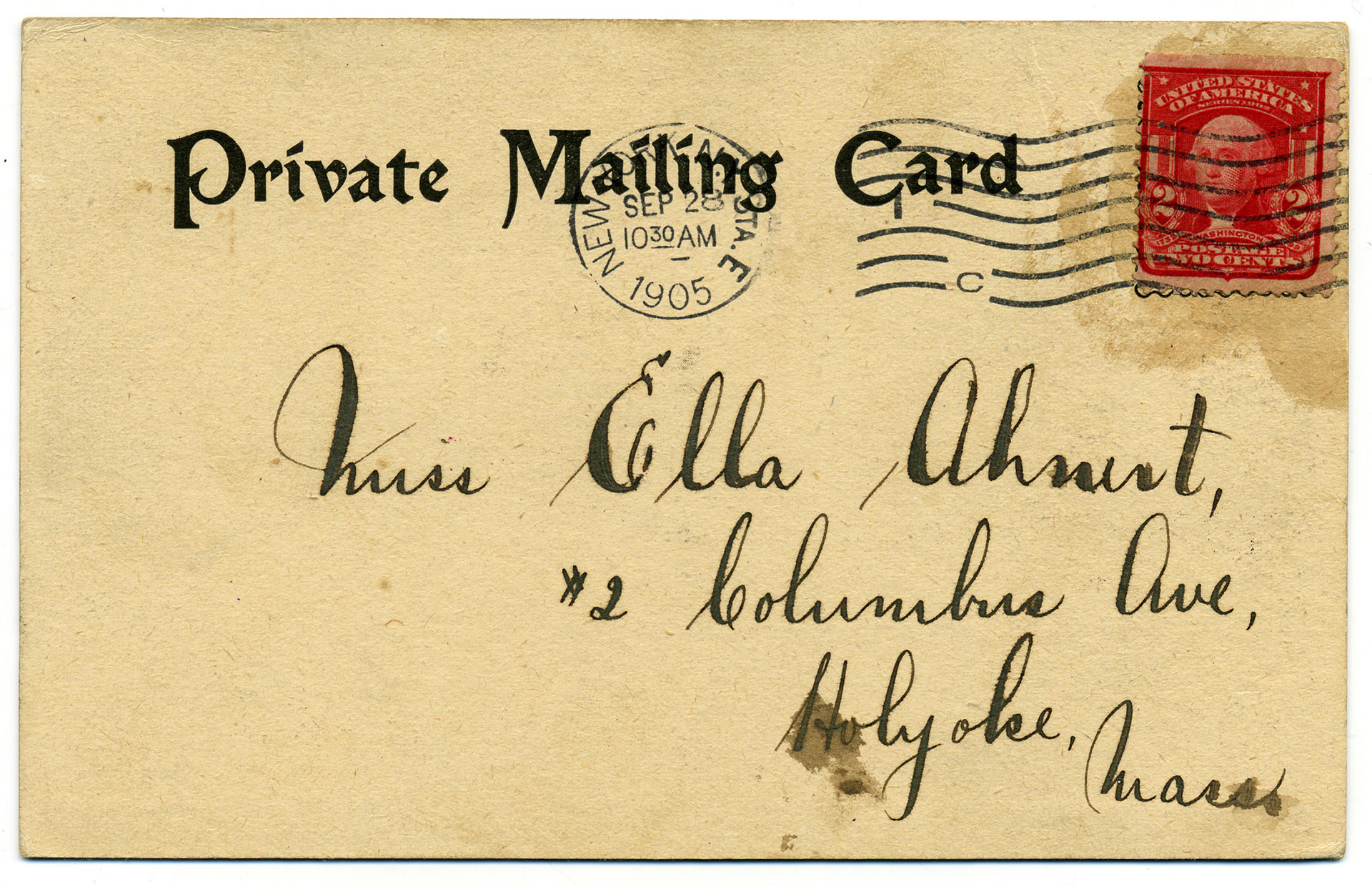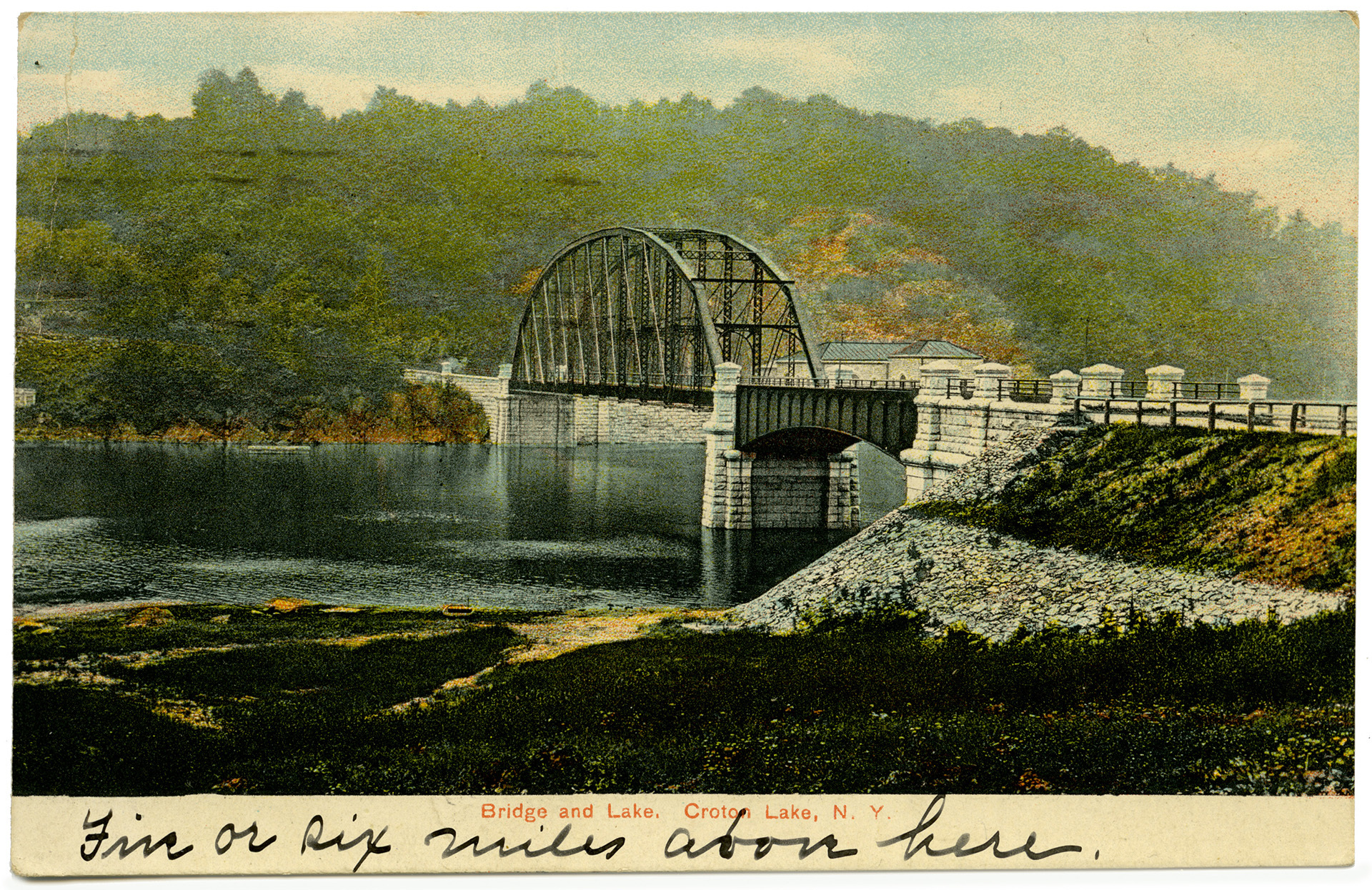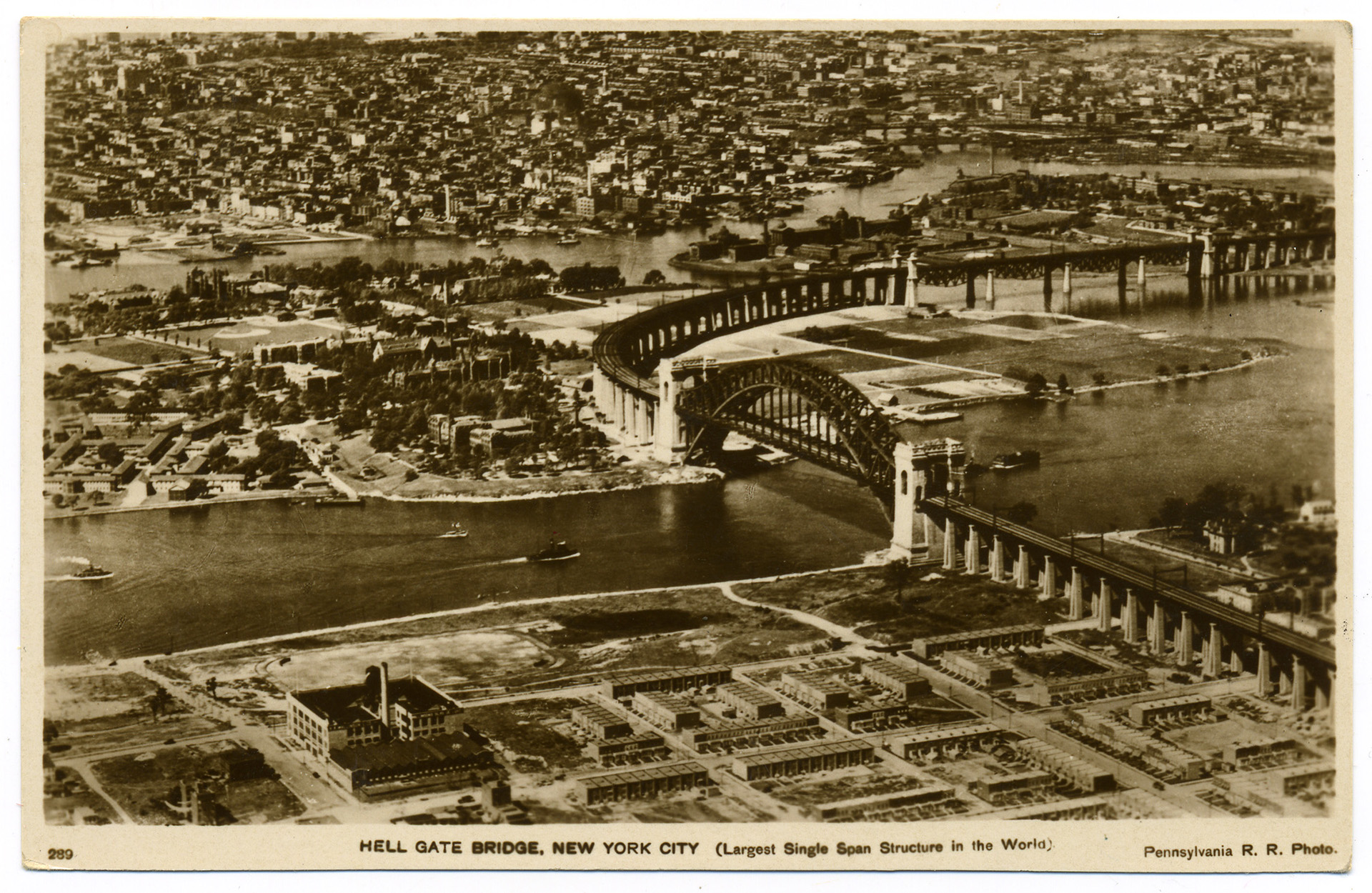About
A Brief History of the Picture Postcard
Picture postcards, either printed or photographic, were enormously popular in the late nineteenth and early twentieth centuries. Their “golden age” is generally considered to be from 1893 to 1918. The first official postcard issued was from the Austrian government in 1869 and by 1873 the United States Postal Service had begun to issue its own cards with stamps already printed on their backs. Early postcards only allowed for the address to appear on the stamp side; the reverse was set aside for correspondence. In 1878, standard dimensions were set for postcards by the World Congress of Universal Postal Unions; by 1886 international circulation was also allowed. At the Philadelphia Centennial Exposition in 1876, souvenir pictures printed on card stock were for sale, each showing a scene from the Expo. They were not intended for mailing, but the idea of a small collectible print stuck. In 1889, the souvenir postcard (for mailing) was introduced at the Paris Expo. The Chicago World’s Fair in 1893 sold color cards featuring scenes from the exhibition with an address line printed on the back; these quickly became collectible.
 |
| private mailing card |
The postcard as an object to be mailed did not entirely catch on in the United States until the “Private Mailing Card Act” in May 1898 set the domestic stamp rate at a penny (it had previously been two cents, as expensive as mailing a first-class letter). Government and private cards then enjoyed the same penny mailing rate, and non-government cards were printed with the phrase, “Private Mailing Card—Authorized by Act of Congress, May 19, 1898.” In the same year Rural Free Delivery was established, making it possible for nearly anyone in the country to send and receive mail. Delivery service was also quite frequent: often the mail arrived three or more times a day. Paper machine-made with chemically treated wood pulp also became more widely available around the same time, so the combination of cheap postage and mass-produced paper set the stage for the explosion in the popularity of postcards.
Publishers often partnered with printers in Germany, a country long known for its high quality of printing. Postcard mailing was at its height from about 1905 to the start of World War I, with hundreds of millions of cards sent a year. Collecting became popular at the same time, and has continued on (though with somewhat diminished interest) ever since.
Common Eras of Postcards
Printed postcards can generally be divided up into several eras. Pictorial cards printed before the Private Mailing Card Act of 1898 are extremely rare and known as pioneer cards. From 1898 until 1907, postal regulations allowed only for the recipient’s address to be written on the back of the card; any correspondence had to be written on the image side. These cards are known as Undivided Back cards. In 1907, postcards with a printed line dividing the back into two sections were introduced in the U.S., one side was for correspondence and the other for the stamp and address; these are known as Divided Back cards. The onset of World War I ended the practice of having cards printed in Germany, but high wartime costs and inexperience on the part of U.S. printers caused the quality to decline. White borders were left around the edges to save on ink costs; thus the period from about 1915 to 1930 is known as the White Border Era.
Around 1930, postcards with a linen pattern simulated on the front began to be printed (1930 to the early 1940s is known as the Linen Era). Around 1939 the color, glossy Photochrome style of card began to appear, which is what most postcards are to this day.
Types of Postcards
Many types of methods of manufacture have been used for printing postcards since their beginnings; they can be divided into those varieties commercially printed with ink on card stock and those that are actual photographs, made by exposing a treated paper to light and chemicals.
The Commercially Printed Postcard
Commercially printed postcards were often reproductions of photographs or works of art. They were printed in black and white or full color (from hand-tinted photographs), showing scenic views, travel destinations, local architecture, advertisements, historic sites, and all manner of tourist attractions. Important to note is that these images were often manipulated by liberal use of airbrushing techniques: Subject matter deemed distracting or outdated was removed. Older cars were replaced by newer ones; telephone poles, electric lights, foliage, and people are often completely removed. Sometimes postcards were based on drawings done before a structure was completed, so buildings might include features that were never built.
 |
| collotype print |
Collotype.Used primarily from the 1870s through the 1930s, one of the popular printing methods for early postcards was collotype: Images were printed from an inked glass plate. The image is converted into a dot pattern by use of a screen, and pattern from a collotype can be described as “reticulated." The irregular reticulation comes from tiny cracks in the gelatin used on the printing plate.
Chromolithography. Chromolithography is a type of color printing using a chemical process, where an oil-based image is applied to a stone or a zinc plate, treated, and prints are made. It was widely used from 1840 to 1930, when offset methods of printing became more popular. Chromolithography was a a cheap alternative to art reproductions, and often was used in artistic (rather than photographic) postcards. The edges of the ink are smooth and often several different colored plates were used for each image.
Letterpress halftone. The letterpress halftone process was used primarily from 1875 to 1970 (graphicsatlas.org) and is identified by “squeeze out” in the dot pattern. This happens because more ink gathers at the edges than in the center of each dot.
Gravure. Gravure methods were used less frequently than collotype for printing postcards but were still well represented. Photogravure is a printing method used from the 1890s on; the grain dot is much subtler than in collotype and may need the magnification of a microscope to see it. Rotogravure was used widely from 1905 on. Like photogravure, the pattern is very fine, but rotogravure prints have a distinctive grid pattern from the screen used on the printing cylinder.
Offset lithography. Offset lithography has been used from the 1950s on; it is recognized by its halftone dot pattern which tend to have a slightly soft edge (graphicsatlas.org).
 |
| photographic postcard |
The Real Photo Postcard
Far less common than the printed postcard, real photo postcards are also important parts of collections. They were printed onto photographic card stock from negatives, either glass plates or film. The primary player in the development of the real photo postcard was the Eastman Kodak Company, who introduced postcard-sized photo stock in 1902. The company also manufactured the 3A Folding Pocket Kodak camera, which used postcard-sized film and printed on “Velox” paper stock, from 1903 to 1911. A machine for developing the film also came out in 1903. From 1906 to 1910, Kodak offered factory negative printing onto card stock. Cyanotype papers were available that could be printed in daylight with only water required to rinse away any unexposed salts--no darkrooms or chemicals were needed. The backs of these commercially produced postcard papers were pre-printed; manufacturers can often be determined by a logo printed on the stamp box. Real photo postcards were often printed in small quantities by businesses but many were also one-of-a-kind. By 1914, amateur photographers were able to “write,” by use of carbon paper, on their prints by using the Kodak Autographic camera. Kodak was by no means the only manufacturer involved in real photo postcards, but the company was aggressive with patenting and advertised its products heavily, so managed to dominate the field.
Resources
Online
Detroit Publishing Company (Library of Congress)
Detroit Publishing Company (New York Public Library)
The Metropolitan Postcard Club of New York City
In Print
Fear, B. (2010). Yesterday's email. Canada’s History, 90(4), 39-40.
Lear, B. A. (2008). Wishing they were there: Old postcards and library history. Libraries & the Cultural Record, 43(1), 77-101.
Merrill-Oldham, J. (1995). Postcards: Navigating the preservation options. In Stevens, N. D. (Ed.), Postcards in the library: Invaluable visual resources (pp. 199-213). Binghamton, NY: The Haworth Press.
Roberts, P. J. (2007, Spring/Summer). Philatelic materials in archival collections: Their appraisal, preservation, and description. The American Archivist 70(1), 70-92.
Roy, L. (1995). A view of main street: The use of postcards in historic preservation. In Stevens, N. D. (Ed.), Postcards in the library: Invaluable visual resources (pp. 141-158). Binghamton, NY: The Haworth Press.
Staff, F. (1966). The picture postcard & its origins. New York: F.A. Praeger.
Value, R.B. (2004). As we were: American photographic postcards, 1905-1930. Boston: David R. Godine.
Wosh, P.J. (1998, Spring). Going postal. The American Archivist, 61(1), 220-239.
Postcard Copyright Information
Resources for New York City’s Bridges
Online
Bridge hunter: Historic bridges of the U.S.
Historic bridges: Promoting the preservation of our transportation heritage.
New Jersey historic bridge survey
New York City Department of Transportation: Bridge FAQs
New York City Landmarks Preservation Commission designation reports
In Print
Doig, J. W., & Billington, D. P. (1994, July). Ammann’s first bridge: A study in engineering, politics, and entrepreneurial behavior. Technology and Culture, 35( 3), 537-570.
Hart, S. (2007). The last three miles: Politics, murder, and the construction of America's first superhighway. New York: New Press.
Greater Astoria Historical Society, & Roosevelt Island Historical Society. (2008). The Queensboro Bridge. Charleston, S.C.: Arcadia Pub.
McCullough, D. G. (1972). The Great Bridge. New York: Simon and Schuster.
New York (City). (c1920). Historical facts in connection with New York City bridges: 1890-1919. New York: City Hall Library.
Plowden, D. (2002). Bridges: The spans of North America. New York: Norton.
Rastorfer, D. (2000). Six bridges: The legacy of Othmar H. Ammann. New Haven: Yale University Press.
Reier, S. (1977). The bridges of New York. Mineola, N.Y: Dover Publications.
Richman, S. M. (2005). The bridges of New Jersey: Portraits of Garden State crossings. New Brunswick, N.J: Rutgers University Press.
Talese, G., & Réthi, L. (1974). The bridge. New York: Harper & Row.
Winpenny, T. R. (2004). Manhattan Bridge: The troubled story of a New York monument. Easton, PA: Canal History and Technology Press.
Wolf, D. E. (2010). Crossing the Hudson: Historic bridges and tunnels of the river. New Brunswick, N.J: Rivergate Books.